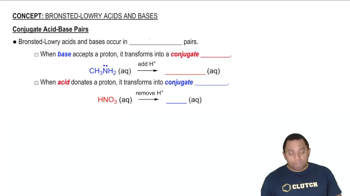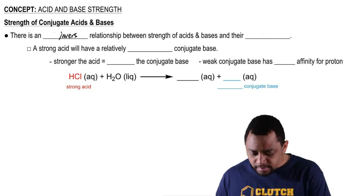Here are the essential concepts you must grasp in order to answer the question correctly.
Conjugate Acid-Base Pairs
Conjugate acid-base pairs consist of two species that differ by the presence or absence of a proton (H+). When an acid donates a proton, it forms its conjugate base, while a base that accepts a proton forms its conjugate acid. Understanding these pairs is crucial for predicting the direction of acid-base reactions and the strength of acids and bases involved.
Recommended video:
Conjugate Acid-Base Pairs
Equilibrium Constant (Kc)
The equilibrium constant (Kc) quantifies the ratio of the concentrations of products to reactants at equilibrium for a given reaction. A Kc value greater than 1 indicates that products are favored at equilibrium, while a value less than 1 suggests that reactants are favored. This concept is essential for determining which conjugate acid-base pair will shift the equilibrium towards products in the given reaction.
Recommended video:
Equilibrium Constant Expressions
Acid-Base Strength
The strength of an acid or base is determined by its ability to donate or accept protons, respectively. Strong acids completely dissociate in solution, while weak acids only partially dissociate. In the context of the question, identifying the stronger base from the conjugate pairs will help predict which pair will effectively react with H2CO3 to produce HCO3- and shift the equilibrium towards products.
Recommended video:
Strength of Conjugate Acids and Bases
 Verified step by step guidance
Verified step by step guidance

